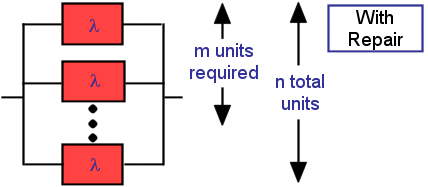

This tool calculates the reliability function and effective failure rate for "m of n" active on-line units. It includes the capability to model units failing in accordance with either the exponential or Weibull failure distributions. For comparison purposes,
it also provides options to output reliability metrics associated with non-repairable scenarios. It is similar to
this tool, but is more comprehensive in that it uses numerical integration to compute the effective
mean time between failure (MTBF), sometimes referred to as the mean time between critical failure (MTBCF). In addition, it handles non-constant unit failure rates using the Weibull distribution and provides graphing capability.
For additional details, click here.
See this page for additional details on time inputs (T) for system restoration.
